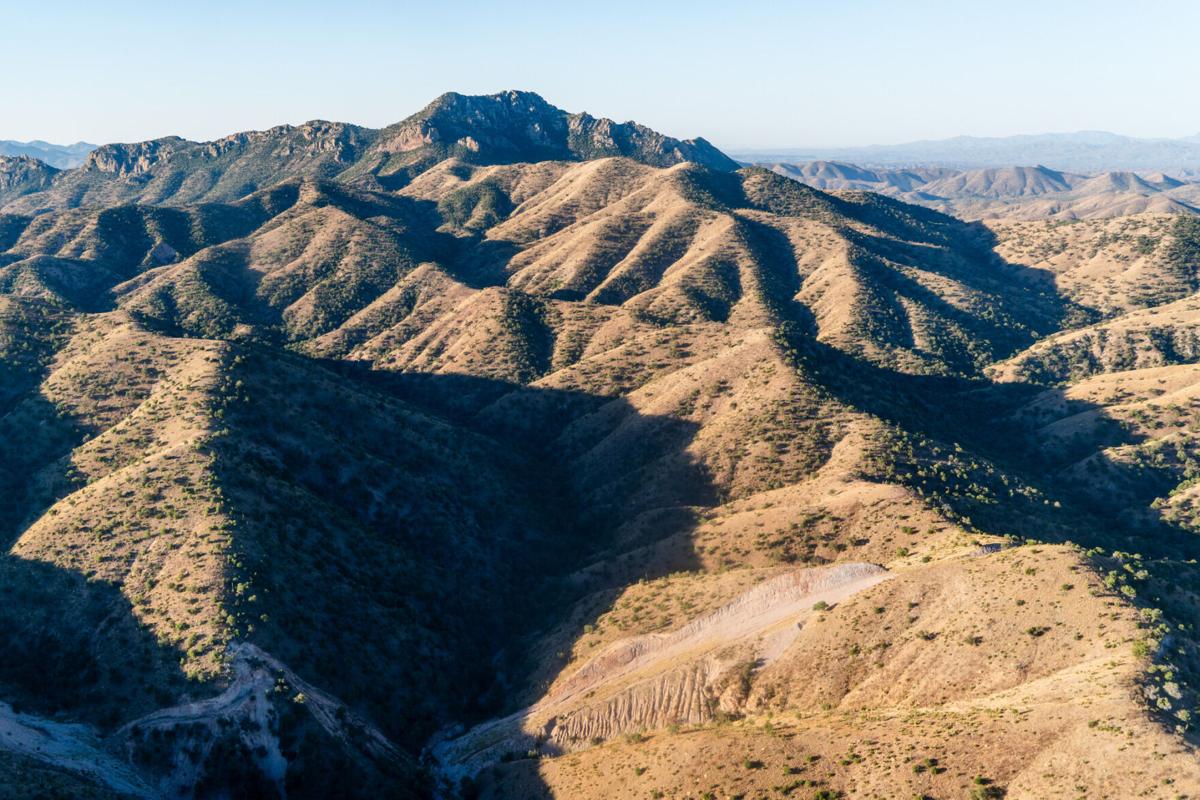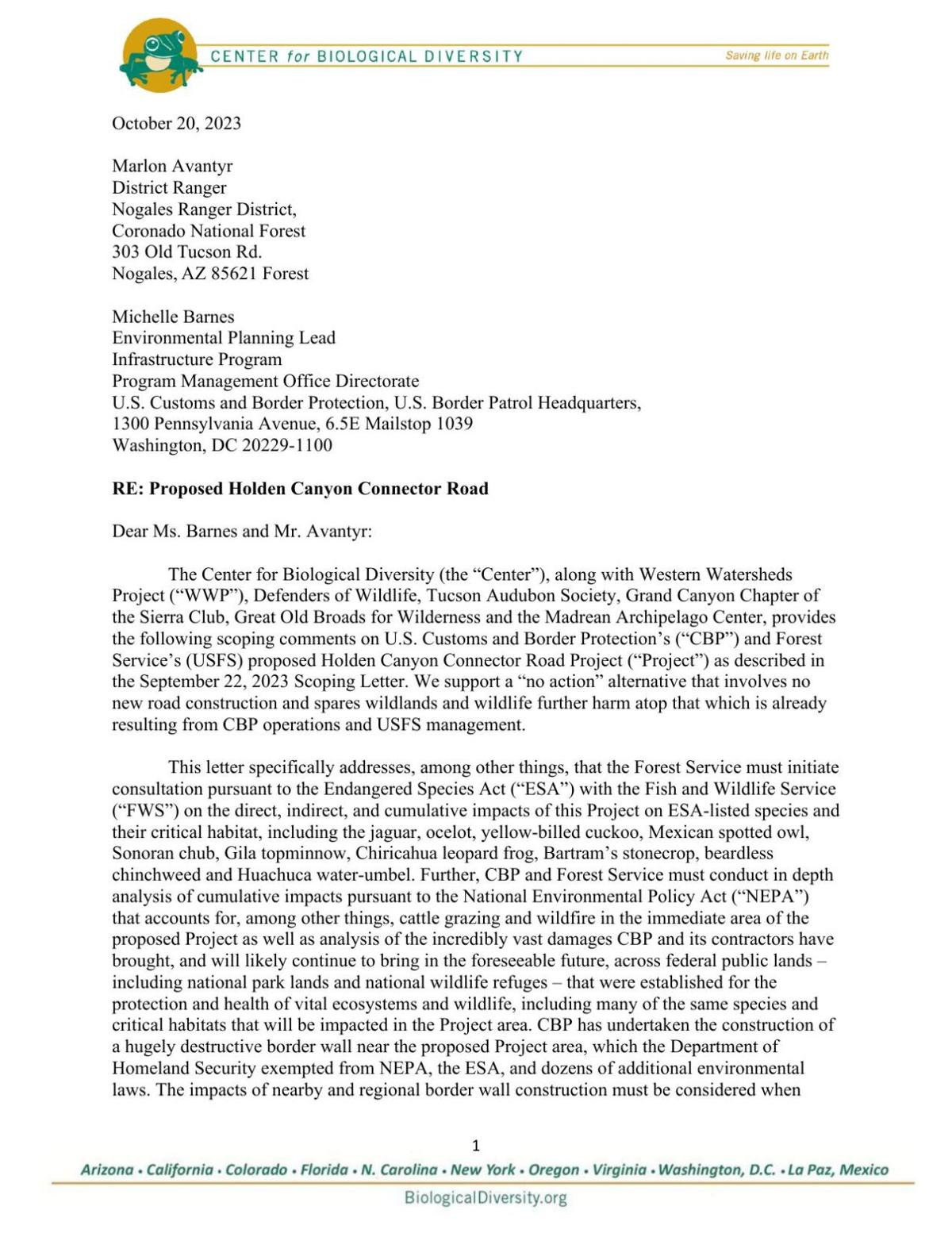Advocates with Tucson’s Center for Biological Diversity say two federal agencies failed to adequately inform the public about a proposed road project’s potential impacts on critical habitats, including that of the jaguar and Mexican spotted owl, in the project area west of Nogales.
The Holden Canyon Connector Road project would add or improve 12 miles of road in the rugged terrain about 10 miles southeast of Arivaca.
U.S. Customs and Border Protection said the construction is needed to improve response times for border agents in the mountainous area between Holden Canyon and Warsaw Canyon. Border agents there face extended drive times due to poor road conditions and at times must patrol on foot, due to impassable terrain, according to CBP’s scoping letter outlining the project’s purpose.
“The limited east/west road access … has constrained agents’ abilities to safely and efficiently respond to this area,” the Sept. 22 letter said. “The purpose of this project is to improve mobility and accessibility for CBP agents responding to and seeking to prevent illegal cross-border traffic, address emergencies involving human health and safety, and prevent or minimize environmental damage arising from occurrence of and response to CBV (cross-border violator) illegal entry on public lands.”
But the scoping letter didn’t address all of the critical habitats that could be affected by the project and made no mention of the jaguar or spotted owl, said Russ McSpadden, Southwest conversation advocate for the Tucson-based Center for Biological Diversity.
“That’s really a big failure,” McSpadden said. “We argue there’s inadequate information in CBP’s letter. It’s really hard to say the public has been fully informed.”
The public comment period — the first step of the environmental review process under the National Environmental Policy Act, or NEPA — ended Oct. 23.
In response to a question from the Arizona Daily Star, a Forest Service spokeswoman said it will not extend the public comment period, but that the public will have other opportunities to weigh in as the agency moves forward with the review process under NEPA.
This was the first of three public comment periods for the road project, said Starr Farrell, public affairs officer for Coronado National Forest. The public can track the project’s progress and upcoming public comment periods on the agency’s website.
In submitted comments responding to CBP’s scoping letter, the Center for Biological Diversity and other conservation groups said, under the Endangered Species Act, the Forest Service must initiate consultation with the U.S. Fish and Wildlife Service about the project’s impact to listed species and their critical habitats, including the jaguar, ocelot, yellow-billed cuckoo, Mexican spotted owl, Sonoran chub and Chiricahua leopard frog.
The new road project lies in “really wild country,” between the port of entry in Nogales and one further west in Sasabe, McSpadden said.
“There’s a lot of really fragile biodiversity out there,” he said, including in the Pajarita Wilderness and the neo-tropical Sycamore Canyon.
Under NEPA, the Forest Service and CBP must consider the cumulative impacts of previous border-wall infrastructure construction, as well as the Holden Canyon road project’s potential impacts, McSpadden said.
The environmental impact of border-region construction under the Trump administration was never evaluated because the administration used a waiver under the REAL ID Act to avoid required reviews, he said.
CBP has become “one of the greatest single threats to the health of the environment of the borderlands,” McSpadden said. He cited groundwater pumping in Organ Pipe Cactus National Monument that threatens the Quitobaquito Springs and blasting in the San Bernardino National Wildlife Refuge that permanently damaged the spring system there. “It’s a death-by-1,000-cuts issue.”
Earlier this year CBP’s remote cameras got photos of an unknown jaguar in the Huachuca Mountains, an area that just a few months earlier had been blocked by stacks of shipping containers installed on the border by former Gov. Doug Ducey, part of a $176 million project that was quickly dismantled.
There still remains a “great connectivity” between the U.S. and Mexico in a lot of jaguar critical habitat, despite border-wall construction, McSpadden said.
“A lot of what happened during the Trump administration was incredibly devastating, but most of it went through the open desert,” he said. “They were getting to some of the places where the Sky Islands, the rugged mountains, cross the border, but they never sealed off those important jaguar movement corridors in several places.”
McSpadden, other conservationists and reporters recently took a flyover flight, provided by Colorado-based wilderness conservation group EcoFlight, to see the terrain of the proposed road-project area, and to view the impacts of previous CBP work in that region.
Some of the blasting work under the previous administration “looks like mountain-top removal” in the Mariposa Canyon area, McSpadden said. Debris fell down into the watershed at the base of the canyon which feeds into the drinking water supply for the city of Nogales, he said.
If officials determine the Holden Canyon project will have significant environmental impacts, they’ll have to prepare an impact statement under NEPA and look for ways to minimize the damage.
Public comment periods are a necessary component of environmental review in sensitive environments, McSpadden said.
“They have to seek public comment and ultimately, they need to respond to all the comments in writing,” he said. “That’s a critical part of the NEPA process.”
A male jaguar not previously detected by researchers was videotaped just three miles south of the recently constructed border wall between Mexico and the United States.
The jaguar appeared for the first time on camera traps along the riparian corridor of Cajon Bonito in Sonora, Mexico. The lands where the jaguar was recorded have been managed by the Cuenca Los Ojos foundation to preserve and restore biodiversity during the last three decades. Researchers have dubbed the jaguar El Bonito.
Credit: Ganesh Marin, the project leader, is a Ph.D. student in the School of Natural Resources and the Environment at the University of Arizona and a National Geographic Early Career Explorer. The research project is a joint effort of the University of Arizona and the University of Wyoming in collaboration with the Cuenca Los Ojos Foundation and members from Santa Lucia Conservancy, National Autonomous University of Mexico (UNAM), Phoenix Zoo and Arizona State University.






